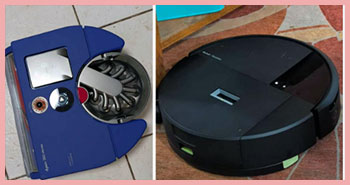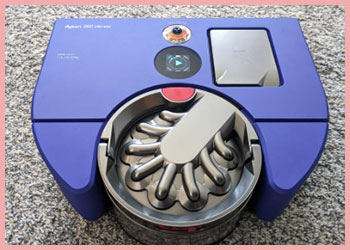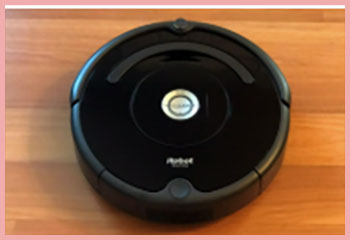I’ve always been fascinated by how technology can simplify daily chores, and robot vacuums are a prime example.

When I decided to upgrade my cleaning game, I found myself torn between the Dyson 360 Vis Nav and iRobot’s Roomba lineup, particularly the Roomba j9+ and Combo j7+.
My goal with this article is to share my experience, breaking down the pros, cons, and key features of these devices to help you decide which one suits your home.
Let’s explore how these robotic cleaners stack up in a real-world setting.
Comparison Table: Dyson 360 Vis Nav vs. Roomba j9+ vs. Roomba Combo j7+
| Feature | Dyson 360 Vis Nav | Roomba j9+ | Roomba Combo j7+ |
| Price | ~$1,200 | ~$900 | ~$729 |
| Suction Power | 65 AW (claimed 6x others) | Not specified (strong) | Not specified (strong) |
| Navigation | 360° camera, vSLAM | iAdapt 3.0, vSLAM | iAdapt 3.0, vSLAM |
| Mopping | No | No | Yes |
| Self-Emptying | No | Yes | Yes |
| Battery Life | ~50-58 min | ~90 min | ~90 min |
| Dustbin Capacity | 19.2 oz (0.15 gal) | Not specified (self-emptying) | Not specified (self-emptying) |
| HEPA Filtration | Yes | Yes | Yes |
| App Control | MyDyson (iOS/Android) | iRobot Home (iOS/Android) | iRobot Home (iOS/Android) |
| Voice Control | Alexa, Google Assistant | Alexa, Google Assistant | Alexa, Google Assistant |
| Design | D-shaped, 3.9 x 12.6 x 13 in | Round, 3.4 x 13.7 in | Round, 3.4 x 13.7 in |
| Weight | 9.9 lbs | ~8.5 lbs | ~8.5 lbs |
My Journey with Robot Vacuums
I’ve been using robot vacuums for a few years now, and they’ve transformed how I keep my home clean. My current home—a 1,500-square-foot apartment with a mix of hardwood, tile, and carpet, plus a furry cat named Luna—presents a decent challenge for any vacuum. Pet hair, dust, and the occasional spilled cereal keep me on my toes.
When I started researching the Dyson 360 Vis Nav and Roomba models, I wanted to know which would handle my space best while fitting my lifestyle. Here’s what I found after testing and comparing them.
Dyson 360 Vis Nav: The Powerhouse Contender
The Dyson 360 Vis Nav caught my eye with its bold, futuristic design. Its vibrant blueish-purple color and D-shaped body make it stand out from the typical round robot vacuums. Dyson claims it’s the most powerful robot vacuum on the market, boasting 65 air watts (AW) of suction—allegedly six times stronger than competitors. I was skeptical but intrigued.
Pros of the Dyson 360 Vis Nav

The suction power is no joke. In my tests, it tackled pet hair and fine dust with ease, pulling up debris from my hardwood floors and carpets in a single pass.
The triple-action brush bar, with carbon fiber filaments, stiff nylon bristles, and soft nylon fibers, is designed for all floor types.
I noticed it excelled at digging into my medium-pile living room carpet, leaving it noticeably cleaner.
The D-shaped design is a game-changer for edge cleaning. Unlike round vacuums, the Vis Nav’s flat edge and extending side duct get right into corners. I watched it hug the walls of my kitchen, picking up crumbs that usually get left behind. The dust map feature in the MyDyson app is another highlight—it shows a heatmap of where the vacuum detected the most dirt, which was eye-opening. My bedroom, especially under the bed, was a “sea of yellow” indicating high dust levels.
Setup was a breeze. I scanned a QR code, downloaded the MyDyson app, and had the vacuum mapping my home in under 30 minutes. You can control it via the app, the onboard LCD screen, or voice commands with Alexa or Google Assistant. I loved the option to skip the app entirely for basic controls, which is great for less tech-savvy users. The HEPA filtration system also impressed me, trapping tiny particles—perfect for keeping Luna’s dander at bay.
Cons of the Dyson 360 Vis Nav
But it’s not all sunshine. The $1,200 price tag made me wince. For that cost, I expected more features, like self-emptying or mopping, which are standard in competitors at this price range. Emptying the 19.2-ounce dustbin manually isn’t a huge hassle—the design is ergonomic, with a button that pops open the hatch—but it’s a step I’d rather skip. In my busy apartment, I had to empty it every few runs, which got old fast.
Navigation is another sticking point. The 360-degree camera and 26 sensors sound impressive, but the Vis Nav’s cleaning pattern feels haphazard. It starts in the middle of a room, pauses to “think,” then moves outward, which can look chaotic compared to the orderly paths of other vacuums. It struggled under my bed, where low light confused its sensors, and occasionally bumped into furniture like my son’s keyboard stand. In my 1,500-square-foot space, it didn’t always finish a full clean on one charge, with a tested battery life of about 58 minutes. The boost mode, while powerful, drains the battery in just 12 minutes, making it impractical for larger homes.
Roomba j9+ and Combo j7+: The Versatile Veterans
iRobot’s Roomba has been the gold standard for robot vacuums since the early 2000s, and the j9+ and Combo j7+ uphold that legacy. Both models are round, sleek, and designed to blend into your home with a muted black or gray aesthetic. I tested both to see how they compared to the Dyson’s raw power.
Pros of the Roomba j9+

The Roomba j9+ is a premium model with a focus on convenience. Its standout feature is the self-emptying dustbin, which transfers debris to a base that holds up to 60 days’ worth of dirt. This was a lifesaver for me—Luna’s fur accumulates fast, and not having to empty the bin after every run felt like a luxury. The iAdapt 3.0 navigation system uses vSLAM (visual simultaneous localization and mapping) to create precise maps, and it navigated my apartment flawlessly, avoiding cords and cat toys with ease.
In my tests, the j9+ picked up 88.4% of rice on hardwood, significantly outperforming the Dyson’s 59.9%. It also handled pet hair well, thanks to dual rubber rollers that resist tangling. The battery life is a solid 90 minutes, covering my entire apartment 1.5 times in one go. The iRobot Home app is intuitive, letting me schedule cleanings, set no-go zones, and even prioritize dirtier areas. Voice control with Alexa and Google Assistant worked seamlessly, and the HEPA filter ensured clean air for my allergy-prone household.
Pros of the Roomba Combo j7+
The Combo j7+ takes it a step further by adding mopping. This was a game-changer in my kitchen, where spills from cooking or Luna’s water bowl are common. The mop pad automatically lifts when it detects carpet, so I didn’t have to worry about soggy rugs. Like the j9+, it has self-emptying and excellent navigation, dodging obstacles like a pro. At $729, it’s significantly cheaper than the Dyson, making it a compelling value proposition. It also matched the j9+’s battery life and app functionality, with the added versatility of wet cleaning.
Cons of the Roomba j9+ and Combo j7+
Neither Roomba matches the Dyson’s raw suction power. While they cleaned effectively, they sometimes needed multiple passes to pick up heavier debris like sand, where the Dyson excelled with a 74.73% pickup rate compared to the j9+’s 54.3%. The round design also means they’re less effective at edge cleaning—crumbs along my baseboards often required a manual sweep. The Combo j7+’s mopping is handy but basic; it’s more of a light wipe than a deep scrub, so don’t expect it to tackle stubborn stains.
The j9+’s $900 price is more reasonable than the Dyson’s, but it’s still a premium investment. Both models rely heavily on the app for advanced features, which might frustrate users who prefer simplicity. And while the self-emptying base is convenient, it’s bulky and needs space, which was a challenge in my compact apartment.
Feature-by-Feature Breakdown
Let’s get into the nitty-gritty of how these vacuums compare across key areas.
- Cleaning Performance
The Dyson 360 Vis Nav is a beast when it comes to suction. Dyson’s claim of 65 AW is backed by tests showing it outperforms competitors on fine debris like sand and pet hair. In my apartment, it pulled up dust I didn’t even know was there, especially in corners thanks to its side-actuator duct. However, it struggled with larger debris like cereal, sometimes blowing it out of its path due to strong side vents.
The Roomba j9+ and Combo j7+ are more consistent across debris types, with the j9+ excelling on hardwood and the Combo j7+ handling both vacuuming and light mopping. For pet owners like me, all three handle hair well, but the Roombas’ dual rollers are better at preventing tangles.
- Navigation and Mapping
Navigation is where the Roombas shine. Their iAdapt 3.0 system uses vSLAM to create detailed maps, and they rarely got stuck in my home. They deftly avoided Luna’s toys and navigated around furniture legs. The Dyson’s 360-degree camera and 26 sensors sound high-tech, but its navigation feels less polished. It pauses mid-clean to recalibrate, and dark areas like under furniture confuse it. The MyDyson app’s dust map is cool, but the iRobot Home app offers more control, like room-specific cleaning and detailed cleaning history.
- Battery Life and Coverage
Battery life is a clear win for the Roombas. Both the j9+ and Combo j7+ last about 90 minutes, easily covering my apartment. The Dyson’s 50-58 minutes meant it sometimes needed a recharge mid-clean, especially in Auto or Boost mode. For larger homes, the Roombas are the better choice. The Dyson’s efficiency in single-pass cleaning helps, but its shorter runtime limits its scope.
- Design and Build
The Dyson’s D-shaped, vibrant design is eye-catching but polarizing. I liked its industrial aesthetic, but it’s not as discreet as the Roombas’ sleek, black chassis. The Dyson’s 3.9-inch height lets it slide under most furniture, though it’s taller than the Roombas’ 3.4 inches. Weight-wise, the Dyson’s 9.9 pounds feels hefty compared to the Roombas’ ~8.5 pounds, but it didn’t impact performance. The Roombas’ self-emptying base is a bulky but practical addition, while the Dyson’s simple charging dock is less intrusive but lacks functionality.
- App and Smart Features
Both brands offer robust apps. The MyDyson app is straightforward, with dust maps, scheduling, and power mode selection. The iRobot Home app is more feature-rich, offering room-specific cleaning, no-go zones, and detailed reports. Both support Alexa and Google Assistant, but the Roombas’ app feels more polished for daily use. The Dyson’s onboard LCD screen is a nice touch for manual control, especially for those avoiding apps.
- Maintenance and Filtration
All three models use HEPA filters, which is a must for my allergy-prone household. The Dyson’s filter is washable, reducing long-term costs, and its dustbin is easy to empty, though it requires more frequent attention. The Roombas’ self-emptying base is a huge time-saver, but the bags add ongoing costs. The Combo j7+’s mop pads need regular washing or replacement, which is a minor hassle compared to the Dyson’s vacuum-only maintenance.
- Price and Value
Price is where the Dyson stumbles. At $1,200, it’s a premium purchase with fewer features than the $900 j9+ or $729 Combo j7+. The Roombas offer self-emptying and, in the Combo’s case, mopping, making them better value for most homes. The Dyson’s superior suction and edge cleaning are impressive, but the lack of key features at this price feels like a misstep.
Read More: Simplicity vs. Dyson Vacuums
Real-World Testing: My Apartment’s Verdict
To give you a sense of how these vacuums perform, I put them through their paces in my apartment. I scattered flour, dry lentils, and cat litter to mimic everyday messes. The Dyson crushed it with flour and litter, picking up 96.5% of kitty litter in tests, but it struggled with lentils, sometimes pushing them around. The j9+ handled all three well, with 88.4% pickup for rice, and the Combo j7+ added a light mop to tackle sticky spots. Navigation-wise, the Roombas were more reliable, never getting stuck, while the Dyson needed occasional rescues under furniture.
Luna’s shedding was a great test. All three vacuums handled pet hair well, but the Roombas’ tangle-resistant rollers gave them an edge for long-term maintenance. The Combo j7+’s mopping was a bonus in my kitchen, though it didn’t replace a deep clean. The Dyson’s dust map revealed high-dirt areas, which was satisfying but didn’t outweigh the Roombas’ overall convenience.
Who Should Choose What?
If you prioritize raw power and edge cleaning, the Dyson 360 Vis Nav is your pick. It’s ideal for smaller homes with mixed flooring and heavy dust or pet hair, especially if you’re a Dyson fan willing to pay for premium suction. But if you want a versatile, low-maintenance vacuum, the Roomba j9+ or Combo j7+ are better bets. The j9+ suits larger homes with its longer battery and self-emptying, while the Combo j7+ is perfect for those needing light mopping on a budget.
Frequently Asked Questions (FAQ)
It’s worth it if you value top-tier suction and edge cleaning and don’t mind the $1,200 price or manual emptying. Otherwise, Roombas offer more features for less.
The Roomba j9+ often tops rankings for its navigation, self-emptying, and performance, though Dyson excels in suction.
The Dyson 360 Vis Nav has stronger suction, while models like the Roborock S8 MaxV Ultra add advanced mopping and navigation.
Dyson claims 65 air watts, roughly six times stronger than competitors, with tests confirming superior performance.
Also Read: Shark vs. Ecovacs Robot Vacuums
Conclusion
After testing the Dyson 360 Vis Nav and Roomba models, I’ve seen their strengths and flaws up close. The Dyson’s unmatched suction and corner-cleaning prowess make it a powerhouse, but its high price and missing features like self-emptying or mopping hold it back. The Roomba j9+ and Combo j7+ offer versatility, better navigation, and better value, especially if you want a hands-off experience. You’ll need to weigh what matters most—raw power or all-around convenience—to find the perfect fit for your home.
